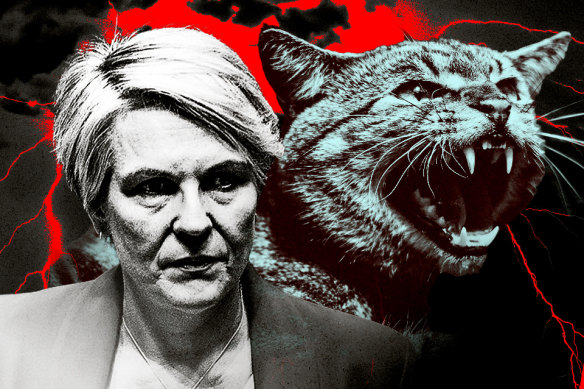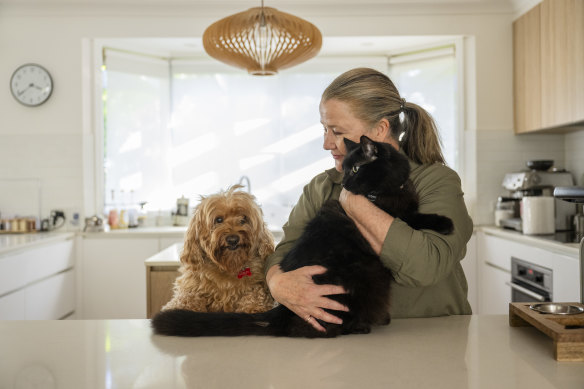By Mike Foley and Millie Muroi
The number of pet cats per household could be capped and curfews rolled out in local areas as Environment Minister Tanya Plibersek prepares to release a nationwide scheme to cut the feral cat population and protect wildlife.
Roaming pet cats kill 546 million animals a year in Australia, including 323 million native animals, according to Australian National University research conducted for the Biodiversity Council, Invasive Species Council and Birdlife Australia.

Environment Minister Tanya Plibersek will release a feral cat management plan by the end of the year.Credit: Aresna Villanueva
There are up to 5.6 million feral cats in Australia, which kill on average more than 1.5 billion native mammals, birds, reptiles and frogs, and 1.1 billion invertebrates each year.
State and territory ministers in November agreed in principle to Plibersek’s draft cat threat abatement plan – the first national compact to tackle the impact of cats on wildlife, and on Wednesday she will announce the final plan will be released by the end of the year.
While it will not force state governments to adopt new rules, it will require them to work with the federal government to reduce cats’ toll on native wildlife.
This could require state governments to pass laws empowering local governments to impose new restrictions on pets.
Plibersek said feral cats would be the focus of the national plan, but it would also encourage cat owners to manage their pets to stop them killing wildlife.
“As well as managing the vast numbers of feral cats, we [the federal government] will also work with state and territory governments to encourage responsible pet ownership,” she said.
New rules canvassed in the draft plan included night-time curfews for pet cats, desexing and registration requirements, household limits on cat numbers and cat-free suburbs for native wildlife hotspots.
Cat ownership rules vary around the country. In Victoria, councils can order cat owners to keep pets inside during specific hours. The Australian Capital Territory requires all cats born after July 2022 to be contained on their owner’s property, while 17 suburbs near wildlife hotspots require all cats to be contained.
NSW and Western Australia would have to create laws to enable local governments to impose restrictions such as cat curfews.
The draft plan said feral cats were the main threat to native animals and birds but noted that pet cats also took a major toll in the suburbs while also escaping and breeding in the wild.
City of Ryde councillor Penelope Pedersen lives near Sydney suburban bushland and keeps her cat Neville inside to protect wildlife.
Pedersen rescued Neville as a kitten five years ago, and he’s been a happy indoor cat that never goes outside.

Penny Pedersen with her inside cat Neville and dog, Harvey, at her Ryde home in Sydney. Credit: Janie Barrett
“Neville likes being inside,” she said. “He’s a really nice cat, sleeps on the bed and is good friends with the dog.”
As a wildlife rescuer, Pedersen said she knew free-roaming cats posed a threat.
“Every week when we pick up possums, lizards and urban wildlife, we see animals that have been pierced by cats’ teeth and dogs’ teeth,” she said. “We see it all the time and it’s heartbreaking.”
Pedersen supports rules to keep cats indoors, which she said would also protect pets from dangers such as being hit by cars.
“It’s good to know where your cat is, and that they’re inside and safe,” she said.
Feral cats have driven 25 Australian species to extinction and currently threaten over 200 more, such as the greater bilby, numbat, Gilbert’s potoroo and night parrots.
The federal government has $60 million committed to feral cat control projects around the country, including trapping and baiting programs in wildlife hotspots. It is also investing in new technology like the Felixer trap, a box placed in the wild that detects feral cats with sensors and sprays them with a toxic gel. It uses artificial intelligence to distinguish feral cats from native animals.
Invasive Species Council advocacy director Jack Gough praised Plibersek for getting state and territory ministers to back her plan and said significant reforms were needed.
“In Victoria, the ban on the use of baiting to control feral cats is putting wildlife at risk and undermining the plan to eradicate cats on French Island to protect endangered bandicoots and shore birds,” he said.
“We have an archaic situation in NSW and Western Australia where local governments cannot implement basic cat curfew laws for pet cats due to outdated state laws.”
Gough said the government must urgently increase funding for feral cat control projects.
“All parties must step up with additional funding for action on cats in the lead-up to the federal election.”
Cut through the noise of federal politics with news, views and expert analysis. Subscribers can sign up to our weekly Inside Politics newsletter.